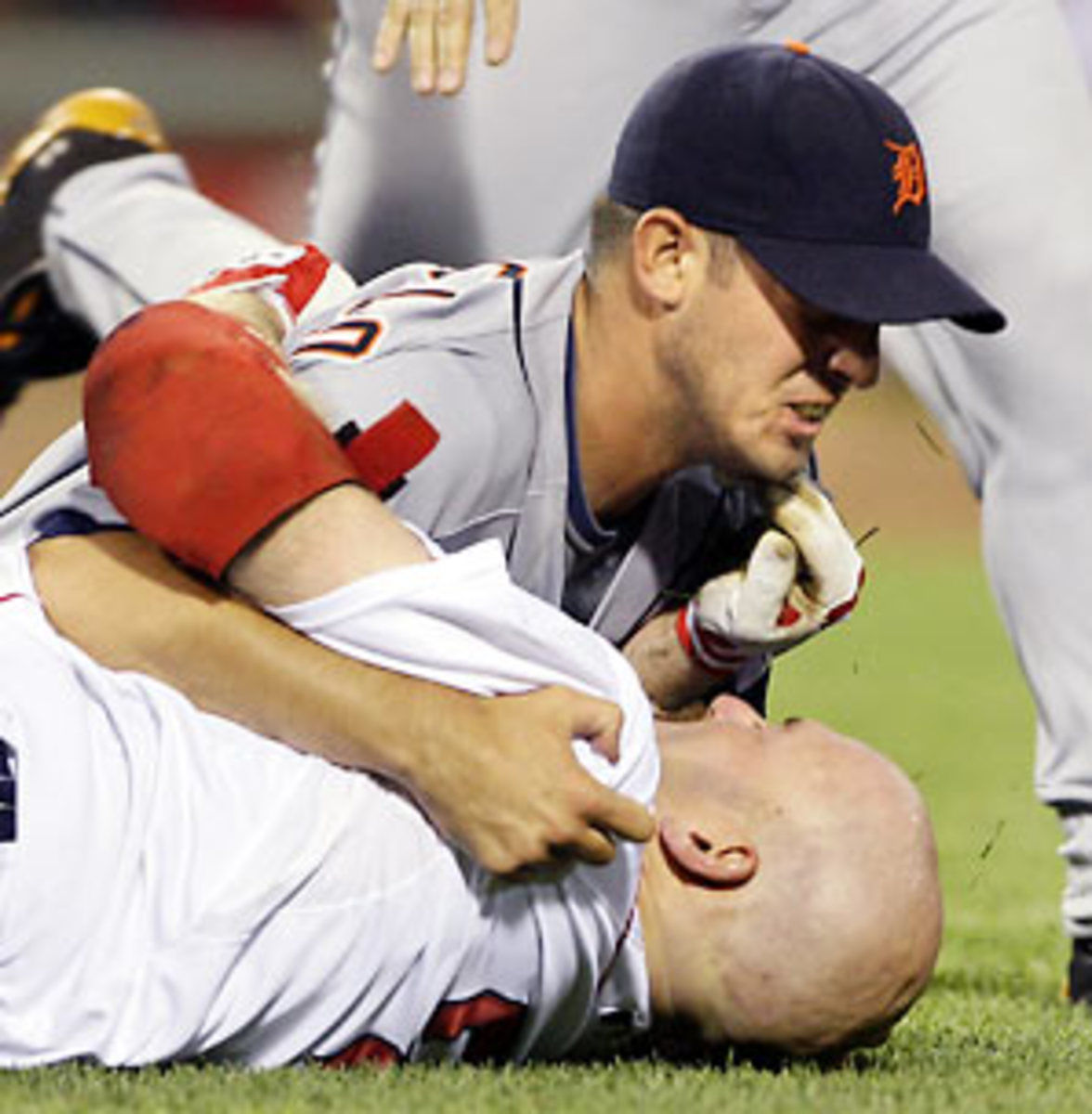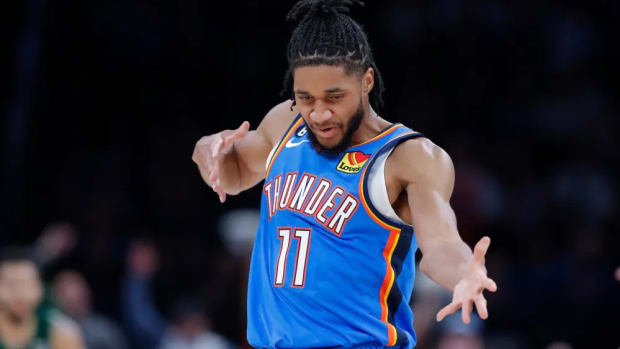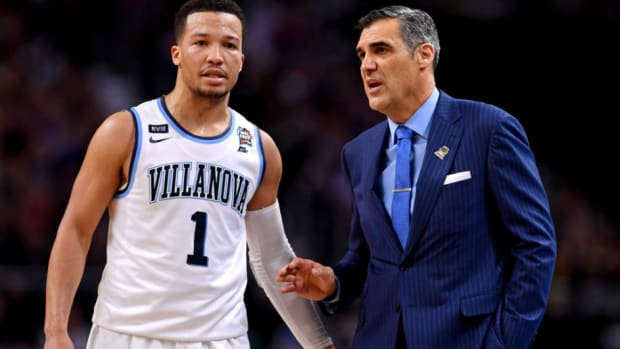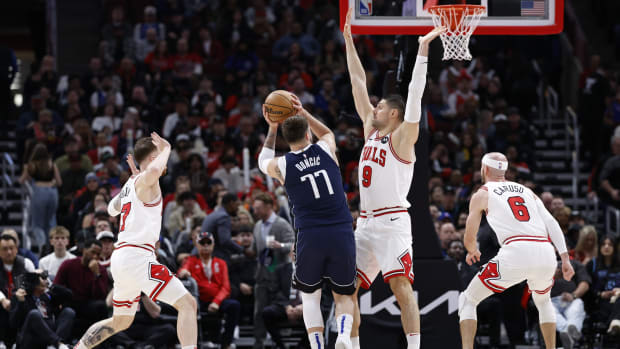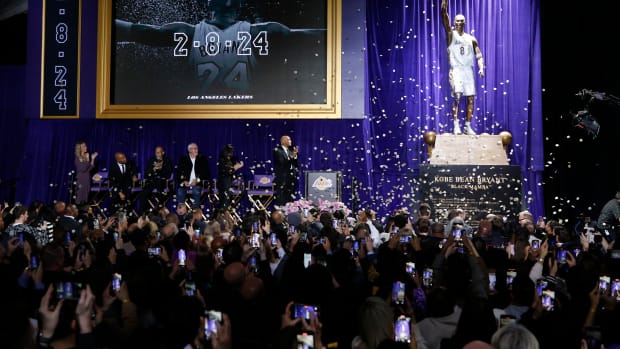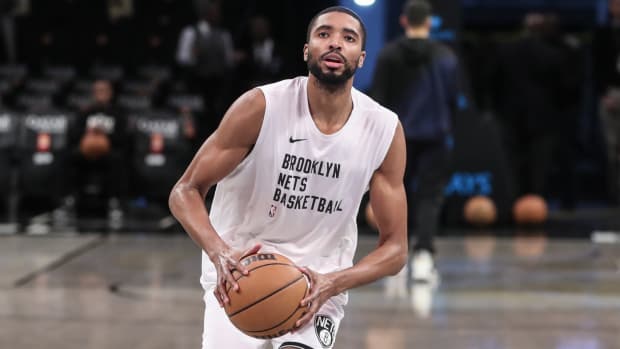It's dangerous business, but sadly beanballs are probably here to stay
The batter's box is where hitters are supposed to go to come alive, not where they go to die. But on Aug. 16, 1920, a pitch from Carl Mays of the New York Yankees smashed into the temple of the Cleveland Indians' Ray Chapman, crushing his skull. Chapman died in the early morning hours of Aug. 17.
That day, the New York Times reported, "Although there is some bitterness against Mays among some of the Cleveland players, manager [Tris] Speaker, in a telephone conversation with Colonel T.L. Huston, part owner of the New York club, said he and his clubmates would do everything in their power to suppress this feeling. 'It is the duty of all of us,' said Speaker, 'of all the players, not only for the good of the game, but also out of respect to the poor fellow who was killed, to suppress all bitter feeling.' "
Speaker's words had the desired effect, temporarily at least. When the Yankees and Indians resumed their series two days after Chapman's beaning, not a single Yankees batter was hit by a pitch. The restraint didn't last. Soon enough, the game was back to the all-but-lawless ways that have governed similar encounters with an eye-for-an-eye vengeance that is, just as potentially devastating and ultimately pointless back then as it is now.
No major league player since Chapman has been killed by a pitch, but hundreds have suffered everything from concussions and broken bones to severe bruising and emotional trauma. Baseball may not be deadly, but it is still dangerous, and nothing in the game is more dangerous than the beanball. Amid a recent rise in beanball wars, the game is coming across as dangerously unregulated.
This past week marked the 89th anniversary of Chapman's death, and it came as two new twists made beanballs an especially hot topic. The first was the announcement that Rawlings was on the verge of releasing a batting helmet that can reportedly withstand the force of a 100 mph fastball, a significant upgrade from current models. The second was the beaning of Mets All-Star third baseman David Wright, who took a 94 mph pitch from the Giants' Matt Cain off his helmet, suffering a concussion and landing on the disabled list.
The new helmet arrived too late to help Wright, but it could be just in time to help prevent similar experiences. He isn't the first player to be hit in the head this year (Edgar Gonzalez of the A's, Jeff Francoeur of the Mets, and Ian Kinsler of the Rangers, to name a few, have also been beaned), but his instance was the most frightening. Wright immediately fell to the ground, lying face-down in the batter's box, a disturbing scene that called to mind some of the more frightening beanings in baseball history (see Conigliaro, Tony and Piazza, Mike).
With Wright writhing in pain, it was uncertain what kind of damage had been done to the Mets' franchise player, but it was certain that the Mets would retaliate. And Johan Santana did just that, not once but twice; first by throwing behind Pablo Sandoval, and then, after Sandoval homered, smoking Bengie Molina on the elbow -- a not-so-subtle lapse in control for a man who had hit only two other batters all year long.
Santana made no effort to hide the fact that he was deliberately targeting the Giants best hitters. "I feel like I have to protect my teammates," he said with a shrug after the game. "If you have been around the game long enough and know how it is, then I don't have to explain. All I do is protect my teammates the right way. That's it."
That is all a part of baseball's "code." On Friday, Mets pitcher Livan Hernandez was asked if he had ever thrown at a hitter on purpose. "Many times," he answered readily. "You always have to take care of the guys on your team. That's what's most important."
Mets outfielder Gary Sheffield said there were times when he played with the expansion Marlins when "we had to ask" to be protected, because the plethora of young players was not yet schooled in the fine art of retaliation. Sheffield, not often known as the voice of reason, also had his own thoughts on how pitchers who throw at hitters should be punished. "[Suspensions] should be based on starts not days," he said. "If you're going to have the courage to hit somebody, then either no one can jump in [to defend you during a fight] or you get two starts." Sheffield has been a frequent bulls-eye in his career. "Pedro [Martinez] threw behind me when I was with the Yankees. They wanted to send a message because I had hit a home run off him," he said. "I knew it was on purpose, but I didn't really think it was warranted."
Purpose pitches are virtually never warranted, but they also aren't going away. Shamefully, neither is the self-policing mentality adopted by players, managers and coaches to mete out justice according to their own rules. Players can live by their code, but that doesn't mean major league baseball ought to accept such vigilante justice as appropriate. The only thing more disturbing than the dramatic overreaction by pitchers to "protect" their teammates is the dramatic under-reaction by the game's powers that fail to effectively prevent such incidents from occurring in the first place. In the place of scattered logic and inconsistent rulings, there ought to be legitimate sanctions and genuine disincentive.
This is especially true in the face of an alarming rise in pitchers who publicly admit throwing deliberately at hitters, with little or no consequence. In May, White Sox closer Bobby Jenks boasted of throwing behind the back of Kinsler, saying, "I meant to. To send a message. I threw it with intention." In late July, Matt Garza of the Rays plunked the Yankees' Mark Teixeira after New York's Joba Chamberlain had thrown a ball near the head of Evan Longoria. Did Garza feel the need to profess his innocence? Hardly. "I just kind of got tired of people brushing [Longoria] back," Garza said. "It's about time someone made a statement."
The Mets-Giants incident was actually the second beanball chapter of last week. The first came in Boston, where the Tigers' Rick Porcello hit the Red Sox's Kevin Youkilis to ignite a bench-clearing brawl that had its genesis in a back-and-forth episode in the series opener the day before. While Porcello claimed it was unintentional, Tigers catcher Gerald Laird all but confirmed the Tigers had taken aim at Boston's Victor Martinez earlier in the game as retribution for Detroit's Miguel Cabrera being plunked on consecutive days. "The one with Martinez was just to show them, 'You're gonna pitch inside, we're gonna pitch inside,' " said Laird. "That's just the way it is. It's baseball."
Unfortunately, that really is baseball; it's an accepted part of the game, as evidenced by the MLB's slap-on-the-wrist approach to punishment. While Porcello received a five-game suspension, that was hardly a sizable deterrent because he was going to miss four games anyway between starts, and as a 20-year-old pitcher trying to stay fresh (he was recently rested for two weeks), it's doubtful the Tigers were sorry to see him forced into an extra off day. Santana not only was not thrown out of the game for obvious retaliation, but also he has not been reprimanded by major league baseball, nor, in all likelihood will he be. That is in keeping with the game's pitiful reaction to Jenks (a $750 fine and no suspension) and Garza (fined an undisclosed sum and no suspension).
Such weak punishment suggests that the crimes committed were weak, but that is not the case. Yankees owner George Steinbrenner once claimed to have consulted with his lawyers on the subject and was told that throwing at hitters "constitutes intent to harm with a deadly weapon." That's one of the charges brought against Cubs minor league pitcher Julio Castillo in a case stemming from an incident last season in which Castillo intentionally threw a ball at the opponents' dugout during a brawl only to have it hit a fan in the stands instead. Castillo was arrested and earlier this month was convicted of felonious assault causing serious physical injury. He was acquitted of the second charge.
In response to being thrown at, hitters often take matters into their own hands, which can lead to fights that cause further suspensions or risk of injury. The Brewers' Prince Fielder was hit by the Dodgers' Guillermo Mota recently. Following the game, Fielder charged the Dodgers clubhouse in a fit of rage, earning himself a five-game suspension and ratcheting up tensions between the two sides. San Francisco's Pablo Sandoval, who has become the Giants' most likely player to be targeted, helped ignite a bench-clearing incident last week when the Dodgers' James McDonald threw inside on him. After the field was cleared, Sandoval got back in the batter's box and eventually walked. When he got to second base, he knew he had overreacted. "I thought, what am I doing?" he says. "It was my fault."
It's refreshing to hear such accountability, even if it came after the fact, but that's certainly not the norm in today's overly aggressive game. And beanballs may be too ingrained to ever be fully eradicated. "It's not something you can prevent," Giants manager Bruce Bochy said. "It's gonna happen."
Bochy was speaking to the futility of trying to stop tit-for-tat exchanges, but in a darker sense, his words sound an ominous note. If nothing more is done to prevent beanballs from happening, then it is a virtual certainty that something terrible is gonna happen.
That does not mean that another on-field death is imminent. But you know what is? Injuries that affect the health of the player and of the game as idols act like idiots.
For now, Ray Chapman remains a horrifying aberration, the only player killed in a major league game. The truly horrifying part is that his manager's words were not heeded longer, and that the dangerous practice of beanballs was not buried the same day Chapman was.
RELATED CONTENT:
• VERDUCCI:MLB needs to curb macho culture• POSNANSKI:Beanballs on a historic rise• GALLERY:Recent beanball incidents






























